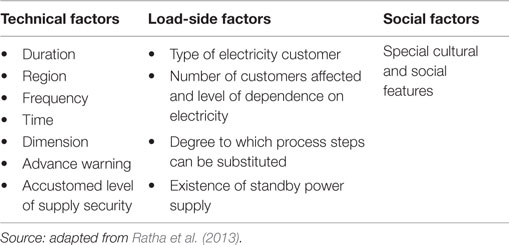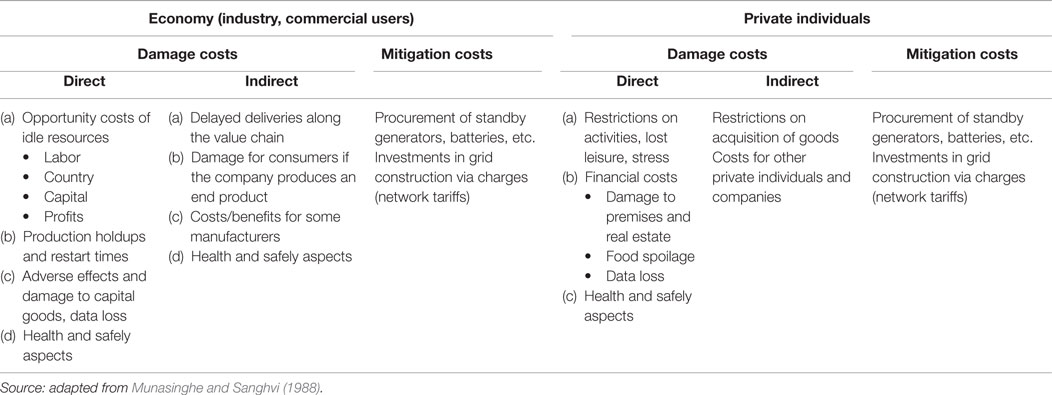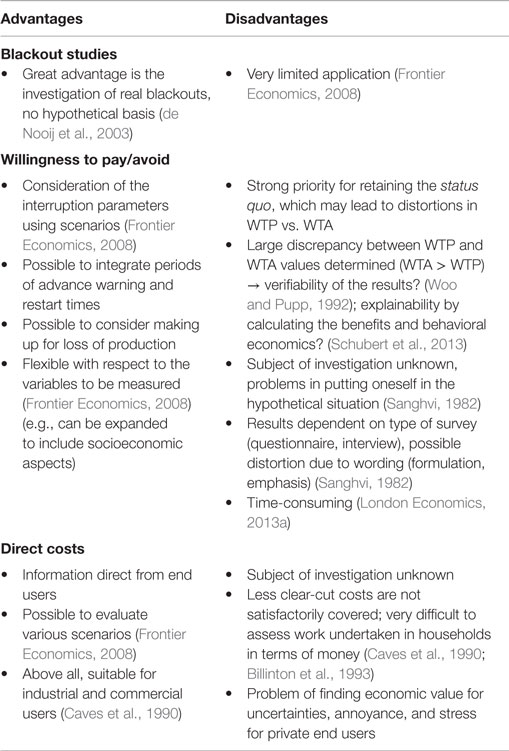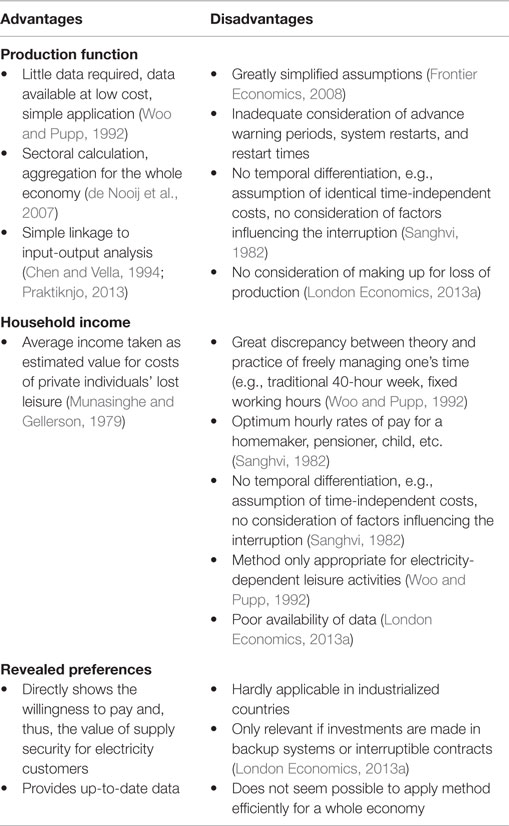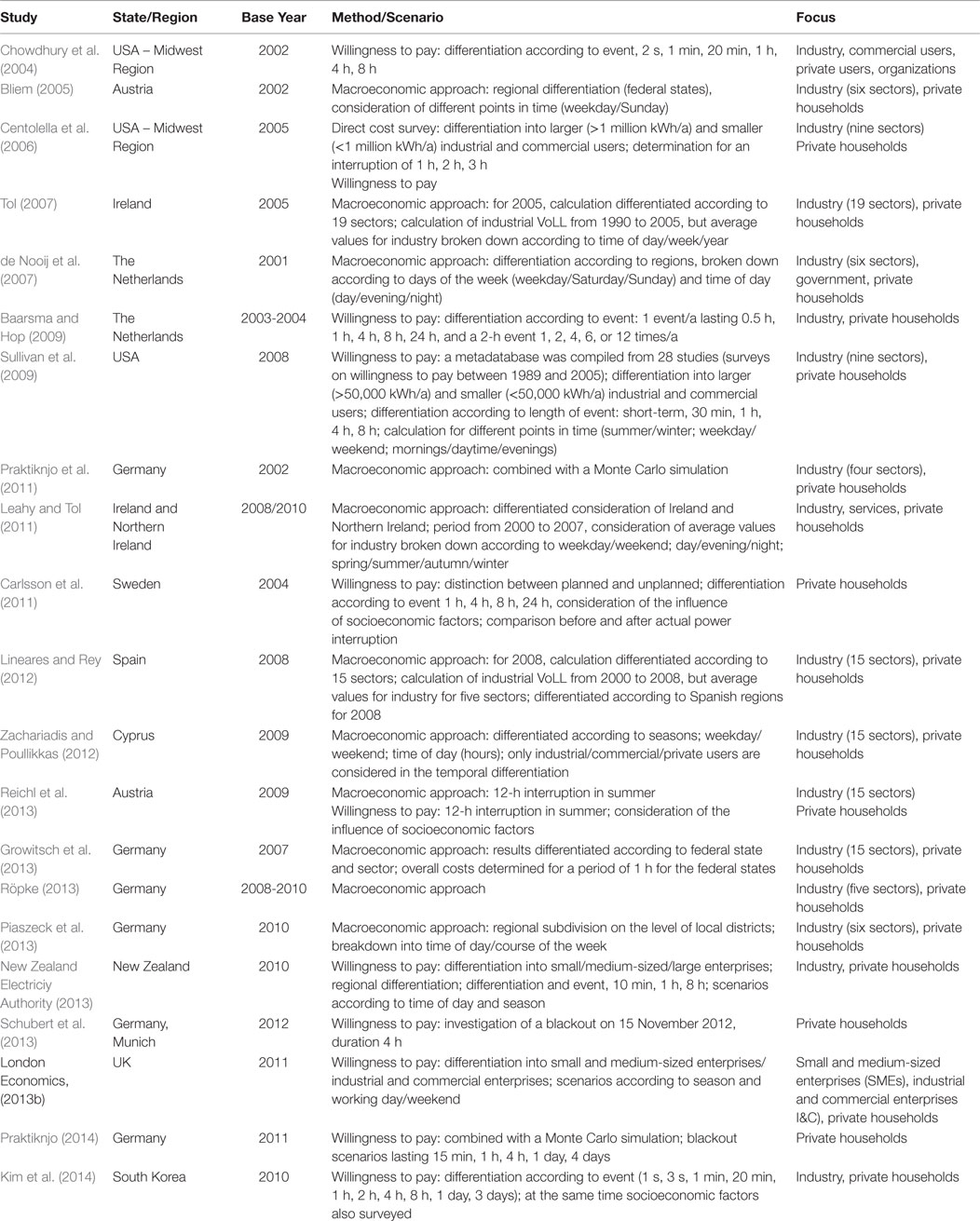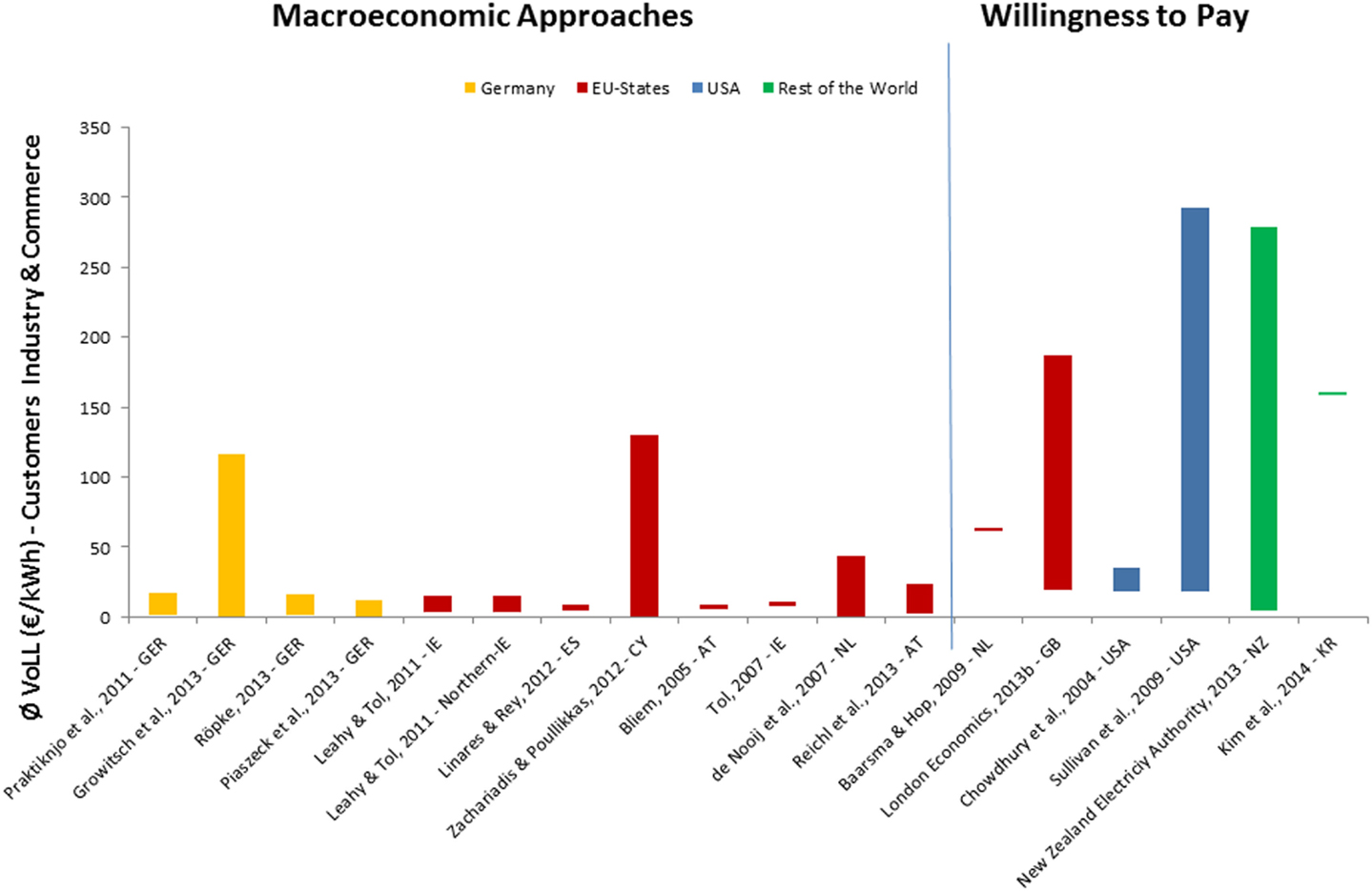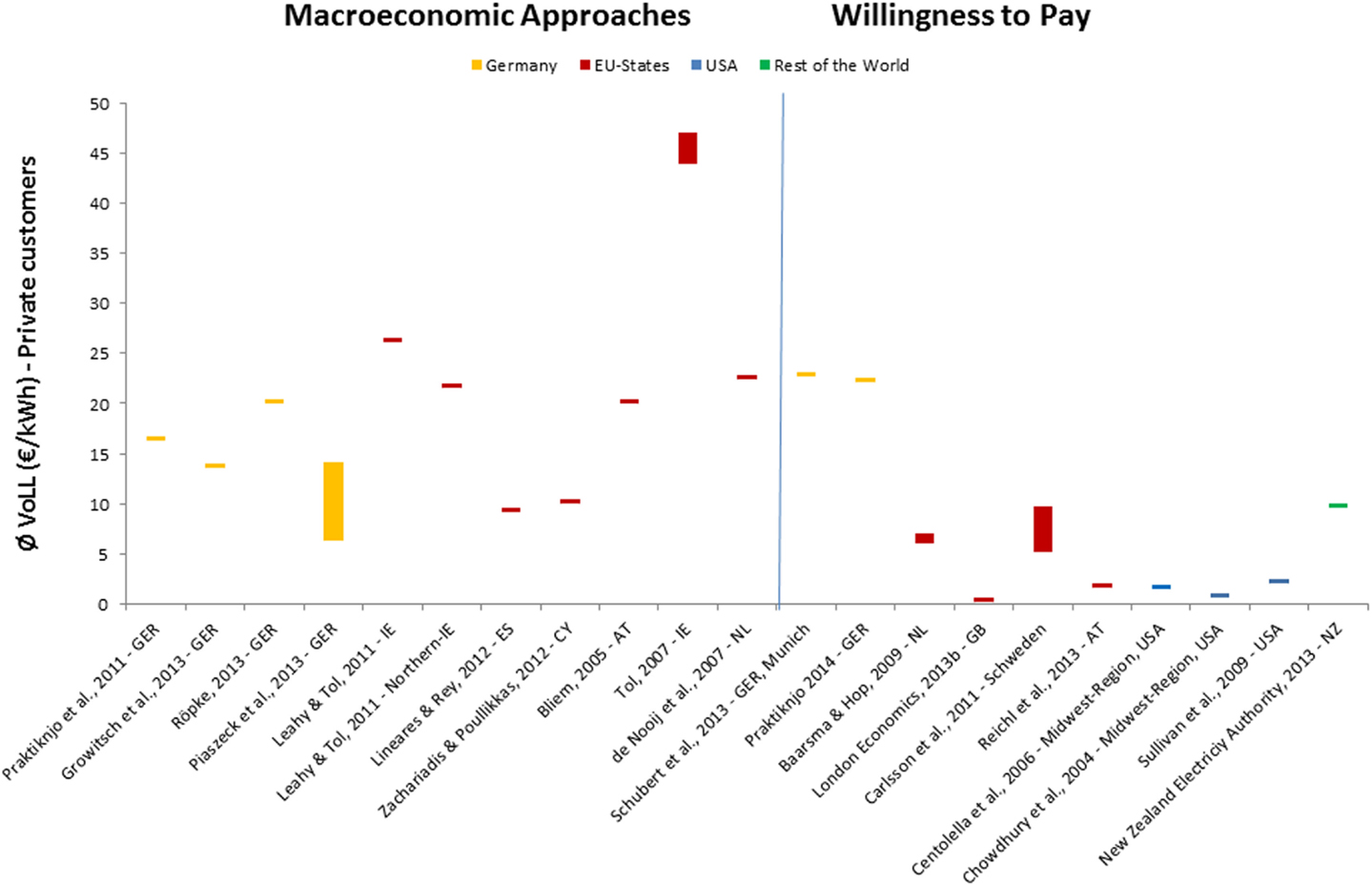Value of Lost Load: An Efficient Economic Indicator for Power Supply Security? A Literature Review
- Institute of Energy and Climate Research – Systems Analysis and Technology Evaluation (IEK-STE), Forschungszentrum Jülich GmbH, Jülich, Germany
Security of electricity supply has become a fundamental requirement for well-functioning modern societies. Because of its central position in all sections of society, the present paper considers the economic consequences of a power supply interruption. The value of lost load (VoLL) is a monetary indicator expressing the costs associated with an interruption of electricity supply. This paper reviews different methods for calculating VoLL, provides an overview of recently published studies, and presents suggestions to increase the explanatory power and international comparability of VoLL.
Introduction
Power blackouts or interruptions of supply all over the world demonstrate the potential of severe socioeconomic disruptions and economic losses. A selection of events during the last 20 years includes blackouts, such as those of 26 April 1995 (USA), 8 June 1995 (Israel), 20 June 1998 (Bangladesh), 21 January 2003 (Brazil), and 14 March 2005 (Australia). The latest blackout in March 2015 plunged Turkey into darkness (Reevell, 2015). Therefore, it is obviously of great importance to analyze blackout events, identify technical options, and develop strategies and instruments to avoid blackouts or to deal successfully with such events (Makarov et al., 2005; Barkans and Zalostiba, 2009) Typically, blackouts are not caused by a single event but by a combination of several malfunctions, such as unforeseen simultaneous interruptions of several power plants, sudden simultaneous high power demand, breakdown of electrical equipment, human errors during maintenance work, switching operations, or power line collapse. Beside this reason, an increasing international interconnection and interdependence of networks may lead to situations in which even failures of a small fraction of nodes in one network can lead to the complete fragmentation of a system of several networks (Buldyrev et al., 2010). Such events are called cascading events. Impressive examples comprise the blackouts in the European Power System on 28 September 2003 and 4 November 2006 (Bundesnetzagentur, 2007; Barkans and Zalostiba, 2009; Buldyrev et al., 2010).
Generally, the power supply industry identified Liberalization and Privatization (which mainly took place in the 1990s) and Expansion of Renewable Energy Production Capacities (which forms an essential option for sustainable energy systems) as the two major trends in the last 10 to 20 years that increase the risk of power blackouts (Aichinger et al., 2011). For industrialized countries aiming at energy sustainability through the increased use of renewable energies for power supply, additional efforts are necessary to preserve the level of power supply security, such as grid adaptations, as Pesch et al. (2014) have shown for Germany. All these options involve increasing costs, which must be considered if power supply security is to be maintained.
On the other hand, efforts to maintain or increase the level of power supply security should be balanced against the damage as a consequence of blackouts, because it is obvious that blackouts involve far-reaching consequences for the entire socioeconomic system (Petermann et al., 2011). Obviously, (nearly) every economic process is highly dependent on a safe and reliable supply of electricity. Technical indices, such as SAIFI, SAIDI, and CAIDI, statistically reflect the security of the system focusing on average power interruption frequency, duration, and intensity. From a socioeconomic perspective, the value of lost load (VoLL)1 is an important indicator addressing the economic consequences of power blackouts and the monetary evaluation of uninterruptedness of power supply. It has a long history and current studies present quantifications.
The present paper takes up the issue of economically evaluating the security of the power supply using the indicator VoLL. However, first of all, the nature of an interruption of the power supply will be described in detail. Consideration will be given to the various factors influencing a blackout (see Characteristics of Power Interruptions). The cost aspects of a blackout will then be discussed and various methods for determining VoLL will be qualitatively evaluated (see Costs and VoLL Measurement Methods). A structured overview will be used to analyze the informative value of a range of various VoLL studies from the past 10 years (see Current VoLL Studies). This will be followed by a qualitative evaluation of the VoLL approach as an economic indicator of power supply security. Furthermore, a framework for VoLL will be presented that will improve the temporal and international comparability of the results (see Suggestions to Increase the Explanatory Power of VoLL). The text concludes with a summary and conclusions (see Summary).
Characteristics of Power Interruptions
Technical and Systemic Characteristics
A power outage occurs when electricity customers (industry, state, individuals) are supplied with less electricity than they require from the electricity system (Ajodhia, 2006). A blackout describes a situation when no electricity is supplied at all. It can have many causes, such as malfunctions or overloading of the various levels of the electricity system, malfunctions in the generation, transmission, or distribution structure, or as a consequence of a lack of raw materials (Ajodhia, 2006). In supply systems with a high and possibly increasingly proportion of renewable energy sources (RES), which cannot be regulated easily and are not suitable for maintaining the base load, there is a growing danger of interruptions at the level of the transmission and distribution grids, as shown by the example of the increasing number of interventions by transmission system operators in Germany to regulate supply.2 However, this is largely of no significance from the perspective of electricity customers. The consequences for electricity customers (material damage, costs) are not usually affected by the cause of the interruption and are contingent on how much they depend on electricity (Sanghvi, 1982) as well as how long they are being interrupted, which will be thoroughly explored later in the paper. The consequences are affected by the factors influencing the outage, which are inherent to each individual case. The character of the individual factors and their combination determine the extent of the consequences. Each outage, therefore, represents a unique event that affects electricity customers to different extents.
In order to represent the multidimensionality of a blackout, the different factors characterizing an interruption of the electricity supply can be broken down into various subcategories. Based on Ratha et al. (2013), the factors influencing the blackout are divided into the subcategories of “technical factors,” “load-side factors,” and “social factors” (Table 1).
The technical factors describe the framework conditions constraining the interruption, the characteristics of which are decisive for the consequences of a blackout. The load-side factors concern the effects that exacerbate the damage arising as a consequence of the structure of the electricity customer affected. In this respect, the customers’ pattern of electricity use is also decisive (Caves et al., 1990). The load-side factors are naturally determined by the technical factors. Finally, the social factors describe the influences that affect the consequences of the blackouts but which are difficult to assess objectively. These are mainly culturally related differences in the economic and social structures of different regions, which lead to differences in power supply security. According to Ratha et al. (2013), it is particularly the cultural factors that cannot be modeled appropriately.
Time Characteristics
In addition to the multifaceted parameters of a blackout described in Section “Technical and Systemic Characteristics,” the time course of a blackout must also be considered in a differentiated manner. The duration of an interruption of the power supply is an essential influencing factor and requires closer consideration. Three basic phases can be identified, each following the other. The first phase concerns preparation for an interruption (if the interruption is planned and announced), such as the modification of working procedures. This requires the workforce and resources to be used for restructuring and preparatory work preventing them from fulfilling their usual duties or functions. The second phase describes the period of the actual interruption of the power supply. The third and final phase is taken to be the interval before the usual production processes are up and running again (Rose et al., 2004). During this phase, the opportunities increase once again to intervene and guide events, although the duration and characteristics of the final phase strongly depend on the crisis management abilities of the executives in a company (Caves et al., 1992).
This breakdown into phases can be applied to all affected electricity customers. If advance notice is given, then, for example, the first phase also begins with preparatory measures for private electricity customers, such as data backup or controlled shutdown of electrical appliances. During the power interruption, all electricity-dependent activities are affected (both housework and leisure activities). The phase of restoring usual activities and rectifying any damage starts with the end of the power interruption.
The different phases may vary in their duration and characteristics so that, for instance, the first step of making preparations may be inapplicable if there is no advance warning. In this case, the two subsequent phases are more extreme.
Technical Indicators for Characterizing Power Interruptions
Following on from Section “Time Characteristics,” a power interruption is a very complex phenomenon that is influenced by a large number of stochastic factors. The Institute of Electrical and Electronics Engineers (IEEE) has compiled standardized technical indices in order to measure, evaluate, and compare the reliability and quality of the power supply. The most important indices for supply security are System Average Interruption Frequency Index (SAIFI), System Average Interruption Duration Index (SAIDI), and Customer Average Interruption Duration Index (CAIDI). They refer to the low-and medium-voltage grids (IEEE, 2004). The determination of the technical indices is subject to clearly defined regulations, for example, only supply interruptions lasting longer than 3 min are taken into consideration. These technical indices form the framework for the regulatory authorities’ process of monitoring supply security. The uniform procedure to be applied in collecting data ensures that values can be compared internationally and also over time. Nevertheless, the informative value of the indices has been criticized in various ways. For example, industry is not satisfied with the length of time during which data on power interruptions are collected. Since industrial plants are often liable to brief power failures, they frequently shut down automatically if the power supply is interrupted for more than about 0.2 s (Schlandt, 2012). Furthermore, only the duration of the interruption itself is considered. Periods of advance warning and restart times are not covered according to the definitions of the technical indices. The indices merely indicate that an interruption has occurred. They do not refer to the measures employed or to the efforts made to avoid an interruption.
Costs and VoLL Measurement Methods
Over and above the acquisition of these purely technical indices, the question arises of the resulting damage and the macroeconomic costs of a power interruption. This requires an economic consideration of power interruptions. To this end, the structure of the different cost categories will be examined in the next section.
Cost Categories for Damage and Mitigation
It seems appropriate to present the various cost types and categories according to the different end users (roughly: industry and commercial users, individuals).
First of all, a distinction can be made between two types of costs. On the one hand, there are costs that can be termed damage costs. On the other hand, end users incur costs that can be better described as mitigation costs. Damage costs can be broken down into direct and indirect costs. Direct damage costs are taken to mean those that are incurred directly by the company or the individual affected. For example, loss of production can be regarded as direct damage for the manufacturer. This loss of production then makes itself felt as indirect damage for other companies in the form of delayed deliveries. Mitigation costs are understood, for example, as costs for the procurement and operation of standby generators. Table 2 gives an overview of the types of costs structured according to end user and according to whether they are damage or mitigation costs.
However, Rose et al. (2004) object that in the course of a supply interruption not only do costs arise, but there are also some market participants who profit from the interruption such as companies commissioned to undertake repair and restoration work as a result of the interruption. At the same time, this means follow-up costs for the companies placing the orders. Even if it does not seem particularly desirable for the companies affected in this context, a power interruption also means savings in electricity costs (Caves et al., 1992), although they generally tend to be small in comparison to the costs of production downtimes (except in the case of energy-intensive manufacturing sectors).
Cost Optimum for Power Supply Security
In order to assess the damage costs of a power interruption, an important approach is the VoLL. VoLL can be understood as an economic indicator for power supply security. VoLL is determined by relating the monetary damage arising from a power outage due to the loss of economic activities to the level of kWh that were not supplied during an interruption (van der Welle and van der Zwaan, 2007). In addition to plotting monetary units against kWh, costs can also be plotted in relation to time. However, a representation in monetary units/kWh is more commonly used (Ajodhia, 2006). Since the VoLL is an economic indicator, the cause of the power interruption is of no interest (Frontier Economics, 2008).
In the optimum case, the level of supply security should be defined in such a way that the marginal damage costs, expressed by VoLL, are equal to the marginal costs for ensuring uninterrupted electricity supply (Röpke, 2013) (see Figure 1).
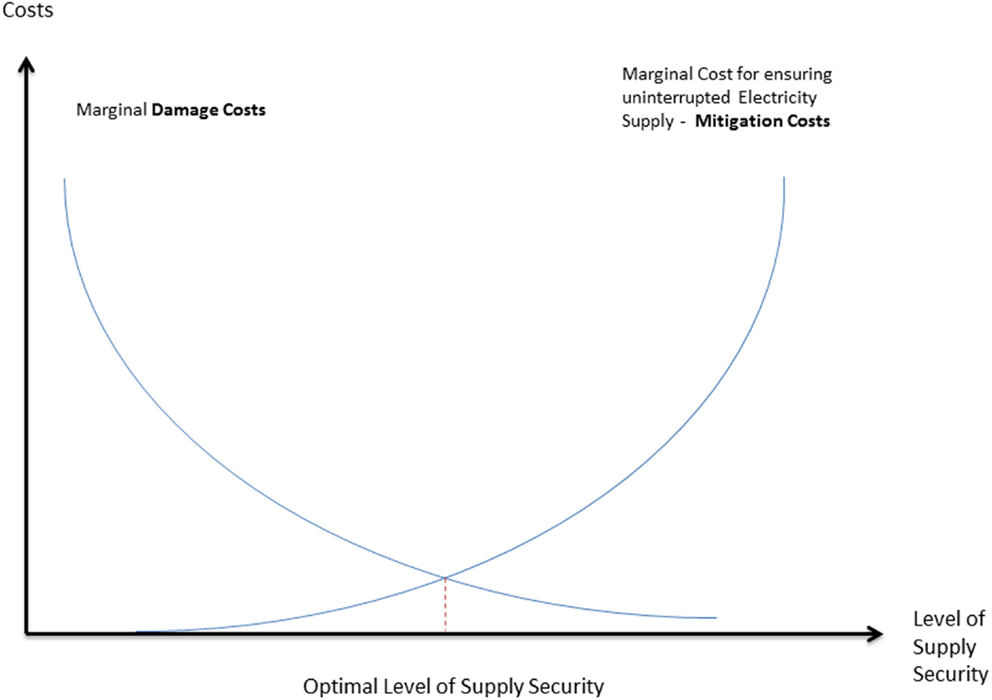
Figure 1. Optimum power supply security. Source Bliem (2005).
Accordingly, the calculation of the economic indicator VoLL represents, on the one hand, an opportunity to determine the level of damage caused by a power interruption, the result of which, on the other hand, describes the value of power supply security (van der Welle and van der Zwaan, 2007).
VoLL Measurement Approaches
Modern industrialized societies are extremely dependent on electricity so that electricity can be regarded both as an essential input factor for all economic processes and also as the basis for many forms of leisure activities. From the economic point of view, it can be argued that all economic activities cease when there is no electricity (Holmgren, 2007). A secure power supply is thus indispensable for electricity-based life in society. It is also regarded as an important locational advantage (von Roon, 2013) and has a macroeconomic value.
Even if VoLL offers the opportunity of expressing the value of power supply security in monetary terms, there is no market on which power interruptions can be traded, which is why VoLL cannot be directly derived as market performance. Consequently, VoLL must be determined by using scientific measuring techniques (van der Welle and van der Zwaan, 2007). The individual techniques are grouped differently in the literature [see Caves et al. (1990), Woo and Pupp (1992), Sullivan and Keane (1995), Lijesen and Vollaard (2004), Ajodhia (2006), de Nooij et al. (2007), and London Economics (2013a)]. A general distinction can be made between direct or survey methods and indirect methods (Table 3). Direct or survey methods obtain their information on the costs of power interruptions directly from end users, whereas indirect methods require other sources of information, such as statistical data (Ajodhia, 2006).
In the literature, the VoLL values of different user groups are calculated separately. This particularly applies to industrial or commercial users and private users. Further subdivisions can also be made, e.g., on the basis of branches of industry. The reason for this is that different users are affected differently by the same power interruption. A subdivision also makes sense since no marketable output results from power consumption in private households (Ratha et al., 2013), which makes it more difficult to quantify the costs of the interruption (LaCommare and Eto, 2006). In the following sections, the techniques will be briefly presented and their advantages and disadvantages will be discussed (see Tables 4 and 5).
Direct Approaches
Blackout Studies
In this approach, the resulting damage costs of a real power interruption are recorded retrospectively. The interruption parameters are clearly defined. This method is mainly used for long-lasting and large-area interruptions (Billinton et al., 1993). A blackout study can also be used as a reference for verifying other VoLL methods. As part of the cost survey, blackout studies also frequently analyze both the performance of the emergency services as well as the impacts on the ecological system (Ajodhia, 2006).
The basis of the survey – a real power interruption – is both the strength and the weakness of this method. The advantage is that VoLL can be measured for a real event. The disadvantage is, however, that blackouts, at least in industrialized countries, are relatively rare and generally occur without warning so that researchers cannot adequately prepare themselves for the event and that information gathering is time-consuming and expensive.
Willingness to Pay/Avoid
A number of econometric methods are available for assessing power outages, of which the best known are contingent valuation and contingent ranking (or Choice) (Ajodhia, 2006). In the contingent valuation method (CVM), individuals are asked, either in questionnaires or direct interviews, to give a monetary value to certain unmarketable goods (in this case a blackout). A clearly defined scenario must be formulated in advance. Accordingly, all the payments and earnings determined by this method are of a hypothetical nature. The questions posed using this method can be generally subdivided into two approaches: willingness to pay (WTP) and willingness to accept (WTA). With respect to a power interruption, customers are asked WTP questions about how much they would pay to either avoid a blackout or to be guaranteed a higher level of supply security. The WTA approach represents the opposite strategy according to which questions are formulated about how much money consumers would have to be offered for them to accept a reduction in supply security or to retain the present level of security instead of being upgraded to a higher level (Caves et al., 1990).
Another technique is the contingent ranking method (CRM). In this case, individuals are asked to rank a number of options (here, interruption scenarios) (Kling et al., 2012). Each option is linked to a certain monetary value, i.e., compensation or cost. WTP and WTA values can be derived from the interviewees’ answers in order to determine the consumers’ preferences (Caves et al., 1990). In CRM, the interviewers set the prices (Ajodhia, 2006). WTP/WTA studies can also take the socioeconomic characteristics of the interviewees into consideration (Portney, 1994).
Direct Costs
In this method, interviewees are given a set of different blackout scenarios, for example, of different durations or starting times, to give them a feeling for the general issues involved in a power outage. For each scenario, the end users are asked about the damage costs that they would experience in each situation. In some studies, interviewees are asked to divide the damage costs into categories. This procedure is mainly applied for industrial and commercial users (Billinton et al., 1993), where different damage categories may result from the different operations in the companies (see Table 2). The identification of different cost categories has two objectives. First, they help provide the interviewees, who may have little experience of blackouts, with an overview of possible types of damage and the consequences so that they can evaluate them. Second, they supply the interviewers with important information on the major cost components. Knowledge of the major cost categories can help to minimize the real damage costs of a blackout (Caves et al., 1990). Ajodhia et al. (2002) summarize these methods in three points:
1. identifying the cost categories,
2. weighting each category with an economic value, and
3. determining the interruption costs by adding up the individual damage costs.
Indirect Approaches
Macroeconomic Approaches
Macroeconomic approaches include the production function approach for calculating VoLL for industrial and commercial electricity customers and the determination of VoLL for private customers by means of the household income as a special case of the production function.
Production Function
The production function approach is based on the understanding that electricity is an important input factor like work or capital for the production of goods and services (Munasinghe and Gellerson, 1979; Munasinghe and Sanghvi, 1988). If an essential input factor in the production process ceases to exist, then a drop in production inevitably results or even a complete production shutdown. The production function approach calculates the consequences of an interruption by relating production outages during the interruption to the kWh that have not been supplied. Essentially statistical data are required and evaluated in order to calculate the outage costs using a production function (de Nooij et al., 2007).
Table 5 compares the advantages and disadvantages. It can be seen that this approach has some weak points that should be noted. However, a great advantage is that the data basis required can usually be supplied by official statistical bureaus and can, thus, be obtained at relatively low cost. Furthermore, by integrating the production function into the input–output calculation, it is possible to determine the consequences of a power outage beyond regional and sectoral boundaries at different impact levels.
Household Income
The approach of determining the interruption costs using household income is based on the logic of evaluating leisure in terms of money. This approach based on Becker (1965) is summarized very succinctly by de Nooij et al. (2007). According to de Nooij et al. the essence of Becker’s theory is that private individuals do not benefit from money or goods alone but from a combination of goods and time purchased with money. In this way, private individuals produce added value by using time and money as input factors. According to this logic, private individuals can also be regarded as production units. As an example, de Nooij et al. (2007) say that merely owning a television set does not in itself represent a benefit or added value for an individual, since the owner also needs time in order to watch television.
In general, it can be said that the value of the income from additional working hours drops the more hours a person works. At the same time, the value of leisure increases since longer working hours necessarily lead to less leisure. Correspondingly, each person has an optimum number of working hours. In this optimum state, the pay for the last hour of work is equivalent to the value of an additional hour of leisure so that the value of an hour of leisure corresponds to a person’s hourly rate of pay.
Furthermore, it is assumed that housework interrupted by a blackout must be undertaken at a later time so that this time cannot then be used for recreation. This assumption leads to 1 hour of housework being equated to 1 hour of leisure (de Nooij et al., 2003, 2007).
A power outage, thus, limits the freedom of private electricity customers in managing their time and forces them to change their preferred habits even if many of their activities can be performed at a later time without great effort or financial expenditure. Overall, determining VoLL using the income of private households follows a clear theoretical derivation. Unfortunately, transferring this logic to reality causes certain restrictions, such as differentiating between a homemaker, pensioner, and child, or if temporal differentiation is not taken into consideration.
Revealed Preferences
Another approach to determining the costs of power outages is the derivation of VoLL from current market behavior. In this case, VoLL is either derived from the behavior of companies and households with respect to their investment activities, for example, standby generators or batteries, or from the conclusion of interruptible supply contracts. These expenditures can then be analyzed with respect to the willingness of electricity customers to pay for uninterruptible power supply. These investments are not damage costs but rather mitigation costs (Table 2). However, the question arises of whether investments in backup systems are voluntary or rather, as in the case of hospitals, governed by legislation (Röpke, 2013).
Assuming a very high level of supply security, as in most developed countries, this method is not applicable in practice since the investment activities of electricity customers are not accessible to analysis. At the same time, conditions, for instance for concluding interruptible supply contracts, are at least in Germany insufficient to provide comprehensive information on the WTP on the part of industrial and private electricity customers.
Current VoLL Studies
Characteristics
Now that the economic indicator for evaluating the security of the power supply, VoLL, and the various survey and calculation methods have been presented in Section “VoLL Measurement Approaches,” the following will give an overview of current studies on VoLL. The studies were published between 2004 and 2014.
Table 6 distinguishes the studies according to the country or region investigated and the base year analyzed. Consideration is also given to which interruption scenarios were assumed in the studies and what methods were used to calculate VoLL. Finally, the table shows the areas on which the respective studies focused.
Some trends can be perceived from Table 6:
- It is immediately apparent that studies on determining VoLL have been performed in a large number of countries. The determination of VoLL is, thus, an issue that has been considered and explored in an international context. However, a regional cluster is clearly visible. Of the 21 studies, 3 relate to the USA and 16 to member states of the European Union. Germany takes first place with six studies followed by Austria, the Netherlands, and Ireland with two each. From the studies relating to Germany, it can be concluded that the motivation for the analyses is the increasing integration of RES into the energy system.
- With respect to the past decade, the number of publications increased in the period 2011–2014. Fourteen studies were published during this period, but only seven from 2004 to 2010. This trend can also be explained by the significant increase in the expansion of RES in recent years (for example, all the studies on Germany were published after 2011), which leads to power outages being increasingly regarded as a real danger.
- Furthermore, it can be seen from the table that almost without exception macroeconomic approaches and surveys on WTP are applied.3 In this context, studies that make use of macroeconomic approaches tend to give more differentiated consideration to the industrial sectors in their calculations than studies that apply WTP approaches.
- The table also shows the boundary conditions that are of particular significance for the different authors. A comparison of the scenario frameworks shows that different degrees of consideration were given to the factors influencing a power outage (Table 1). This is particularly apparent in the assumed duration of the interruption. The periods analyzed range from a few seconds to 3 days.
- Moreover, it becomes apparent that the analyses focus on different end-user groups, whereby a distinction was generally made between industrial or commercial and private electricity customers. Considerable differences can be seen in the depth of the sectoral differentiation of the industrial sectors. For example, Tol (2007) differentiates 19 industrial sectors whereas Baarsma and Hop (2009) regard industry as one overall sector.
Quantitative Results
The following figures show the results of the VoLL studies from Table 6, broken down according to methodology applied and end-user group (industrial and commercial end users in Figure 2 and private end users in Figure 3). Due to the different degrees of differentiation, the VoLL results of the studies are shown as ranges.4
As a whole, the following trends can be perceived:
- Heterogeneity of the VoLL level in and among the end-user groups: for the industrial and commercial sectors, the results range from a few €/kWh to more than € 250/kWh. This could be due, for example, to the different industrial structures in the individual countries. These ranges for the industrial and commercial sectors are therefore high. The large differences between the VoLL values for individual countries or groups of countries are also striking. The differences range from a few €/kWh for EU member states (Bliem, 2005; Tol, 2007; Lineares and Rey, 2012) to more than € 250/kWh for the USA and New Zealand (Sullivan et al., 2009; New Zealand Electriciy Authority, 2013). For private end users, the values range from a few €/kWh (Reichl et al., 2013) and up to about € 45/kWh (Tol, 2007). In this case as well, structural differences, such as country-specific industrial structures and differences in salary level, may provide an explanation. The VoLL for industrial and commercial end users tends to be considerably higher than that for private end users.
- Vice versa, the level of VoLL in the end-user groups depends on the methodological approach. In the studies examined here, there are great differences between the results obtained by the different methods. An obvious explanation is the fact that the results of the studies shown here were determined by two fundamentally different methodological approaches (macroeconomic vs. WTP). It is striking that the average VoLL values for private electricity customers in studies whose results are calculated using the macroeconomic approach are appreciably higher than those in studies based on the WTP approach. In the macroeconomic approaches, VoLL is generally in the range of ~€ 10 to € 25/kWh, whereas in surveys of WTP the maximum VoLL is generally ~€ 10/kWh. For industry and commerce, in contrast, the VoLL results based on the WTP method considerably exceed those obtained on the basis of macroeconomic approaches.
Nevertheless, these explanations can only justify some of the differences. Upon closer consideration, it becomes apparent that, for example, the studies by Praktiknjo et al. (2011), Growitsch et al. (2013), Piaszeck et al. (2013), and Röpke (2013) regard the whole of Germany as the area of study, but the damage costs differ greatly. Another explanation can, therefore, be found in the differences in the more detailed methodological structure of the studies. In this respect, two essential factors have an impact. First, the consideration and weighting of the technical factors from Table 1 play a major role. If different assumptions are made in structuring the framework of the scenario, for instance about the duration or the regional location of the blackout [in the present case, Praktiknjo et al. (2011) and Röpke (2013) consider Germany as a whole, Growitsch et al. (2013) consider the level of the federal states, and Piaszeck et al. (2013) consider the regional districts], then this affects the results obtained. Second, the subdivision of the industrial sectors influences the resulting VoLL values. If the economy as a whole is considered, then VoLL represents a mean. The more extensively the economy is broken down, the more differentiated the VoLL values, and the ranges tend to increase.
In summary, apart from the typical structural features of the income and industrial structures of the countries, three fundamental influences can be identified:
- choice of method,
- structure of the scenario framework of the hypothetical power outage, and
- breakdown of the industrial sectors, as well as boundaries and level of differentiation.
Suggestions to Increase the Explanatory Power of VoLL
According to definition, VoLL is determined by relating the monetary damage arising from a power interruption (due to the loss of economic activities) to the level of the kWh that are not supplied during an interruption.
On the basis of this definition, a number of methodological approaches and a wide variety of differently structured methods have been developed, as shown in Section “Introduction.”
From the discussion in Section “Quantitative Results,” it can be concluded that the framework definition of VoLL is so broad that the understanding of the concept and of the problem is not sufficiently harmonized and the indicator values cannot, therefore, be properly compared.5 This is particularly problematic since it is claimed that the indicator should ensure recognized international comparability of the economic evaluation of power supply security. A general criticism is that the definition of VoLL is so all-embracing that it can be used to justify a large number of different procedures. This reduces the informative value of VoLL considerably since the results cannot be integrated into a larger context by means of comparisons and, thus, it is only possible to represent individual cases. Consequently, a uniform framework as a basis for comparison makes an important contribution to improving this indicator enabling it to provide more informative value on an international level. This requires clearly defined specifications. Technical indices that map power supply security, such as SAIDI, are subject to clearly defined criteria and, thus, fulfill these conditions.
The following procedure is proposed in order to develop a uniform framework for determining VoLL. First of all, as an essential prerequisite, it must be ensured that one single method is employed (macroeconomic or WTP). In the next step, the framework of the outage must be clearly defined, i.e., the factors from Table 1 must be given equal consideration. And in a third step, the breakdown of the industrial sectors must be coordinated both with respect to their delimitation and also the degree of differentiation.6
The clarification of the general analytical framework ensures a uniform and harmonized procedure, thus, providing the basis for international comparability. The VoLL determined on this basis offers the opportunity to place the individual results in an international context and also to consider them over time.
The realistic nature of the VoLL determined in this way can be increased even further by integrating damage-aggravating factors (e.g., influence of preparatory and restart times on the duration of the outage) and damage-mitigating factors (e.g., proportion of internal electricity generation, stockkeeping, making up for production losses, restructuring process steps, advance warning). However, the integration of such factors leads to a reduction in international comparability since the inclusion of such factors requires a solid data basis that in many cases cannot be supplied (or only in part) by official statistical offices and is, thus, frequently not accessible.
This context reveals the problems associated with deciding on a focus, i.e., either as realistic as possible or with the greatest possible international comparability. Since VoLL is completely lacking in international comparability, a uniform analytical framework is urgently required. As soon as this common basis has been created, further steps should be taken to clarify which damage-aggravating and which damage-mitigating influences can be integrated – while maintaining international comparability. However, this still requires extensive discussions both with respect to the methodological approach and also to harmonizing the data basis.
Summary
The review and analysis of 21 studies on the VoLL published in the past 10 years revealed four different aspects that have a fundamental influence on the calculated VoLL.
– country-specific features of the industrial and social structures,
– choice of method,
– structure of the scenario framework of the hypothetical power outage, and
– breakdown of the industrial sectors, as well as boundaries and level of differentiation.
Country-specific features are of particular significance in identifying the results but cannot be varied for the analysis. The three other factors that can affect the VoLL calculation are the choice of method, the structuring of the scenario framework, and the breakdown of the industrial structure by data processing. The different weighting of these aspects is responsible for the large range of VoLL in the results of the analyzed studies.
Overall, the analysis of recent VoLL studies has shown that, according to the present state of the art, VoLL is only capable of mapping one individual case as an economic evaluation index of power supply security, and the respective results must be considered and assessed against the background of the analytical framework. The informative value of these results is not sufficient for comparisons with the results of other studies.
If VoLL can be determined according to a uniformly defined procedure, it may become a decisive factor on which decisions for and against investments for grid optimization and expansion may be based. Furthermore, VoLL may also become extremely important for location decisions on the part of companies. Regions with high blackout probabilities and costs are less attractive for companies to retain existing or establish new operations. Moreover, VoLL could help to ensure an optimum distribution to end users of the remaining electricity in the case of a power outage, as far as this is possible with the technical options available. Further developing the VoLL approach as an economic index would, thus, effectively complement other technical indices.
Conflict of Interest Statement
The authors declare that the research was conducted in the absence of any commercial or financial relationships that could be construed as a potential conflict of interest.
Footnotes
- ^In electric industry and in the literature following terms “Value of Customer Reliability,” “Cost of Unserved Energy,” “Cost of Power Interruption,” or “Cost of Electricity Outages,” are used synonymously to address the phenomenon of VoLL.
- ^In 2003, the transmission system operator TenneT had to intervene twice, whereas this increased to 387 times in 2007 and in 2012 the number of interventions rose to 1213 (Falthauser and Geiß, 2012; Barth, 2013).
- ^Only Centolella et al. (2006) use the direct cost approach in a subsection of their study.
- ^All values in 2013 euros (Deutsche Bundesbank, 2014; Wirtschaftskammer Österreich, 2014).
- ^CEER (2010) makes a proposal for a guideline of estimation of costs due to electricity interruption. However, this is based on a fragmentary consideration of VoLL methods, because macroeconomic approaches are not recognized (although approx. 50% of recently published Studies apply this method).
- ^In this context, attention must be paid that the data basis is harmonized on an international level. It is important not to aim for the greatest possible level of differentiation but rather to ensure international comparability.
References
Aichinger, M., Bruch, M., Münch, V., Kuhn, M., Weymann, M., and Schmid, G. (2011). Power Blackout Risks. Munich: Allianz Global Corporate & Specialty (AGCS) and The Chief Risk Officer Forum (CRO). Available at: http://www.agcs.allianz.com/insights/white-papers-and-case-studies/?c=&page=11
Ajodhia, V. (2006). Regulating Beyond Price – Integrated Price-Quality Regulation for Electricity Distribution Networks. Delf: Delft University.
Ajodhia, V., van Gemert, M., and Hakvoort, R. (2002). Electricity outage cost valuation: a survey. Discussion Paper, DTe, The Hague.
Baarsma, B. E., and Hop, J. P. (2009). Pricing power outages in the Netherlands. Energy 34, 1378–1386. doi: 10.1016/j.energy.2009.06.016
Barkans, J., and Zalostiba, D. (2009). Protection against Blackouts and Self-Restoration of Power Systems. Riga: RTU Pulishing House.
Barth, T. (2013). “The German energiewende: shining or warning example for Europe? (Vortrag),” in 5th Conference ELECPOR, 2013. Lisboa.
Billinton, R., Tollefson, G., and Wacker, G. (1993). Assessment of electric service reliability worth. Int. J. Electr. Power Energy Syst. 15, 95–100. doi:10.1016/0142-0615(93)90042-L
Bliem, M. (2005). Eine makroökonomische Bewertung zu den Kosten eines Stromausfalls im österreichischen Versorgungsnetz. Kärnten: Institut für Höhere Studien (IHSK).
Buldyrev, S. V., Parshani, R., Paul, G., Stanley, H. E., and Havlin, S. (2010). Catastrophic cascade of failures in interdependent networks. Nat. Lett. 464, 1025–1028. doi:10.1038/nature08932
Bundesnetzagentur. (2007). Report by the Federal Network Agency for Electricity, Gas, Telecommunications, Post, and Railways on the Disturbance in the German and European Power System on the 4th of Nevember 2006. Available at: http://www.bundesnetzagentur.de/SharedDocs/Downloads/EN/BNetzA/Areas/ElectricityGas/Special%20Topics/Blackout2005/BerichtEnglischeVersionId9347pdf.pdf?__blob=publicationFile
Carlsson, F., Martinsson, P., and Akay, A. (2011). The effect of power outages and cheap talk on willingness to pay to reduce outages. Energy Econ. 33, 790–798. doi:10.1016/j.eneco.2011.01.004
Caves, D. W., Herriges, J. A., and Windle, R. J. (1990). Customer demand for service reliability in the electric power industry: a synthesis of the outage cost literature. Bull. Econ. Res. 42, 79–121. doi:10.1111/j.1467-8586.1990.tb00294.x
Caves, D. W., Herriges, J. A., and Windle, R. J. (1992). The cost of electric power interruptions in the industrial sector: estimates derived from interruptible service programs. Land Econ. 68, 49–61. doi:10.2307/3146742
CEER. (2010). Guidelines of Good Practice on Estimation of Costs Due to Electricity Interruptions and Voltage Disturbances.
Centolella, P., FARBER-Deanda, M., Greening, L. A., and Kim, T. (2006). Estimates of the Value of Uninterrupted Service for the Mid-West Indipendent System Operator. McLean: Science Applications International Corporation.
Chen, C.-Y., and Vella, A. (1994). Estimating the economic costs of electricity outages using input-output analysis – the case of Taiwan. Appl. Econ. 26, 1061–1069. doi:10.1080/00036849400000122
Chowdhury, A. A., Mielnik, T. C., Lawion, L. E., Sullivan, M. J., and Katz, A. (2004). “Reliability worth assessment in electric power delivery systems,” in Power Engineering Society General Meeting, 2004, (Denver: IEEE), 654–660.
de Nooij, M., Bijvoet, C., and Koopmans, C. (2003). “The demand for supply security,” in Research Symposium European Electricity Markets, (The Hague).
de Nooij, M., Koopmanns, C., and Bijvoet, C. (2007). The value of supply security. The costs of power interruptions: economic input for damage reduction and investment in networks. Energy Econ. 29, 277–295. doi:10.1016/j.eneco.2006.05.022
Deutsche Bundesbank. (2014). Euro-Referenzkurse der Europäischen Zentralbank – Jahresendstände und -durchschnitte. Available at: http://www.bundesbank.de/Redaktion/DE/Downloads/Statistiken/Aussenwirtschaft/Devisen_Euro_Referenzkurs/stat_eurorefj.pdf?__blob=publicationFile
Falthauser, M., and Geiß, A. (2012). Zahlen und Fakten zur Stromversorgung in Deutschland. Münch: Wirtschaftsbeirat Bayern.
Growitsch, C., Malischek, R., Nick, S., and Wetzel, H. (2013). The Costs of Power Interruptions in Germany – An Assessment in the Light of the Energiewende. Cologne: Institute of Energy Economics at the University of Cologne (EWI). Working Paper 13/07.
Holmgren, ÅJ. (2007). “A framework for vulnerability assessment of electric power systems,” in Critical Infrastructure Reliability and Vulnerability, eds Murray A. and Grubesic T. (Berlin: Springer-Verlag), 31–55.
Kim, C.-S., Jo, M., and Koo, Y. (2014). Ex-ante evaluation of economic costs from power grid blackout in South Korea. J. Electr. Eng. Technol. 9, 796–802. doi:10.5370/JEET.2014.9.3.796
Kling, C. L., Phaneuf, D. J., and Zhao, J. (2012). From exxon to BP: has some number become better than no number? J. Econ. Perspect. 26, 3–26. doi:10.1257/jep.26.4.3
LaCommare, K. H., and Eto, J. H. (2006). Cost of power interruptions to electricity consumers in the United States (US). Energy 31, 1845–1855. doi:10.1016/j.energy.2006.02.008
Leahy, E., and Tol, R. S. J. (2011). An estimate of the value of lost load for Ireland. Energy Policy 39, 1514–1520. doi:10.1016/j.enpol.2010.12.025
Lijesen, M., and Vollaard, B. (2004). Capacity Spare? A Cost-Benefit Approach to Optimal Spare in Electricity Production. The Hague: CPB – Central Planning Bureau. CPB document No. 60.
Lineares, P., and Rey, L. (2012). The Costs of Electricity Interruptions in Spain. Are We Sending the Right Signals?. Vigo: Economics for Energy. WP FA5/2012.
London Economics. (2013a). Estimating the Value of Lost Load – Briefing Paper Prepared for the Electric Reliability Council of Texas, Inc. Boston: London Economics.
London Economics. (2013b). The Value of Lost Load (VoLL) for Electricity in Great Britain. London: London Economics.
Makarov, Y., Reshetov, V., Stroev, V., and Voropai, N. (2005). “Blackouts in North-America and Europe: analysis and generelization,” in IEEE St. Petersburg PowerTech, (St. Petersburg: IEEE), 1–7.
Munasinghe, M., and Gellerson, M. (1979). Economic criteria for optimizing power system reliability levels. Bell Econ. J. 10, 353–365. doi:10.2307/3003337
Munasinghe, M., and Sanghvi, A. P. (1988). Reliability of electricity supply, outage costs and value of service: an overview. Energy J. 9, 1–18. doi:10.5547/ISSN0195-6574-EJ-Vol9-NoSI2-1
New Zealand Electriciy Authority. (2013). Investigation into the Value of Lost Load in New Zealand – Report on Methodology and Key Findings. Wellington: New Zealand Electriciy Authority.
Pesch, T., Allelein, H. J., and Hake, J. F. (2014). Impacts of the transformation of the German energy system on the transmission grid. Eur. Phys. J. Spec. Top. 223, 2561–2575. doi:10.1140/epjst/e2014-02214-y
Petermann, T., Bradke, H., Lüllmann, A., Paetzsch, M., and Riehm, U. (2011). Was bei einem Blackout geschieht – Folgen eines langandauernden und großflächigen Stromausfalls. Berlin: TAB – Technikfolgen-Abschätzung beim Deutschen Bundestag.
Piaszeck, S., Wenzel, L., and Wolf, A. (2013). Regional Diversity in the Costs of Electricity Outages: Results for German Counties. Hamburg: Hamburg Institute of International Economics (HWWI). Research Paper 142.
Portney, R. P. (1994). The contingent valuation debate – why economists should care. J. Econ. Perspect. 8, 3–17. doi:10.1257/jep.8.4.3
Praktiknjo, A. J. (2013). Sicherheit der Elektrizitätsversorgung – Das Spannungsfeld von Wirtschaftlichkeit und Umweltverträglichkeit. Berlin: Institut für Energietechnik, Fachgebiet Energiesysteme Berlin, Technische Universität Berlin.
Praktiknjo, A. J. (2014). Stated preferences based estimation of power interruption costs in private households: an example from Germany. Energy 76, 82–90. doi:10.1016/j.energy.2014.03.089
Praktiknjo, A. J., Hähnel, A., and Erdmann, G. (2011). Assessing energy supply security: outage costs in private households. Energy Policy 39, 7825–7833. doi:10.1016/j.enpol.2011.09.028
Ratha, A., Iggland, E., and Andersson, G. (2013). “Value of lost load: how much is supply security worth?,” in Power and Energy Society General Meeting (PES), 2013, (Vancouver, BC: IEEE), 1–5.
Reevell, P. (2015). Turkey blackout: massive power outage plunges country into darkness. ABC News. Available at: http://abcnews.go.com/International/massive-blackout-plunges-turkey-darkness/story?id=30024749
Reichl, J., Schmidthaler, M., and Schneider, F. (2013). The value of supply security: the costs of power outages to Austrian households, firms and the public sector. Energy Econ. 36, 256–261. doi:10.1016/j.eneco.2012.08.044
Röpke, L. (2013). The development of renewable energies and supply security: a trade-off anaysis. Energy Policy 61, 1011–1021. doi:10.1016/j.enpol.2013.06.015
Rose, A., Oladosu, G., and Salvino, D. (2004). “Regional economic impacts of electricity outages in Los Angeles: a computable general equilibrium analysis,” in Obtaining the Best from Regulation and Competition, eds Crew M. and Spiegel M. (Dordrecht: Kluwer), 179–210.
Sanghvi, A. P. (1982). Economic costs of electricity supply interruptions: US and foreign experience. Energy Econ. 4, 180–198. doi:10.1016/0140-9883(82)90017-2
Schlandt, J. (2012). Die Angst vorm Dunkel. Frankfurter Rundschau vom. Available at: http://www.fr-online.de/energie/stromausfaelle-die-angst-vorm-dunkel,1473634,19496664.html
Schubert, D. K. J., von Selasinsky, A., Meyer, T., Schmidt, A., THUß, S., Erdmann, N., et al. (2013). Gefährden Stromausfälle die Energiewende? Einfluss auf Akzeptanz und Zahlungsbereitschaft, Vol. 63. Munich: Energiewirtschaftliche Tagesfragen, 35–39.
Sullivan, M. J., and Keane, D. M. (1995). Outage Cost Estimation Guidebook. San Francisco, CA: Electric Power Research Institute.
Sullivan, M. J., Mercurio, M., Schellenberg, J., and Sullivan, F. (2009). Estimated Value of Service Reliability for Electric Utility Customers in the United States. LBNL Research Project Final Report.
van der Welle, A., and van der Zwaan, B. (2007). An overview of selected studies on the value of lost load. Working Paper, Energy Research Centre of the Netherlands (ECN). Amsterdam, 1–23.
von Roon, S. (2013). Versorgungsqualität und -zuverlässigkeit als Standortfaktor. Energieeffizienz und Erneuerbare Energien im Wettbewerb – der Schlüssel für eine Energiewende nach Maß. Munich: Tagungsband zur FfE-Fachtagung FfE-Schriftenreihe – Band, 31.
Wirtschaftskammer Österreich. (2014). Inflationsraten. Available at: http://wko.at/statistik/eu/europa-inflationsraten.pdf
Woo, C.-K., and Pupp, R. L. (1992). Costs of service disruptions to electricity consumers. Energy 17, 109–126. doi:10.1016/0360-5442(92)90061-4
Keywords: power outage, energy security, value of lost load, energy systems, qualitative analysis
Citation: Schröder T and Kuckshinrichs W (2015) Value of Lost Load: An Efficient Economic Indicator for Power Supply Security? A Literature Review. Front. Energy Res. 3:55. doi: 10.3389/fenrg.2015.00055
Received: 26 June 2015; Accepted: 09 December 2015;
Published: 24 December 2015
Edited by:
Luís Alexandre Duque Moreira De Sousa, Public Research Centre Henri Tudor, LuxembourgReviewed by:
Behnam Mohammadi-ivatloo, University of Tabriz, IranPayman Dehghanian, Texas A&M University, USA
Copyright: © 2015 Schröder and Kuckshinrichs. This is an open-access article distributed under the terms of the Creative Commons Attribution License (CC BY). The use, distribution or reproduction in other forums is permitted, provided the original author(s) or licensor are credited and that the original publication in this journal is cited, in accordance with accepted academic practice. No use, distribution or reproduction is permitted which does not comply with these terms.
*Correspondence: Thomas Schröder, t.schroeder@fz-juelich.de
 Thomas Schröder
Thomas Schröder Wilhelm Kuckshinrichs
Wilhelm Kuckshinrichs